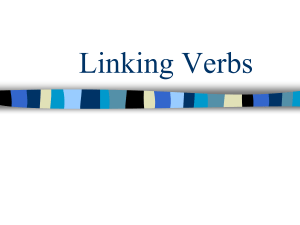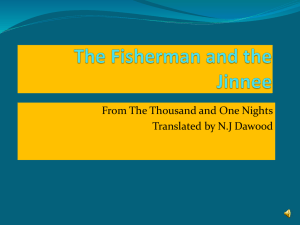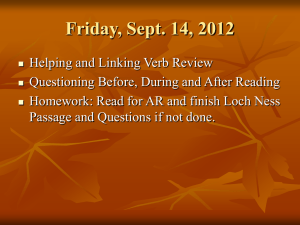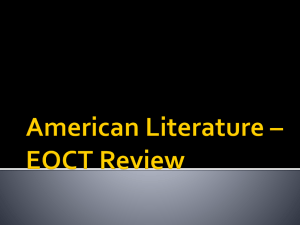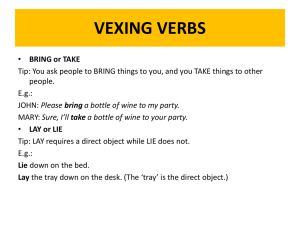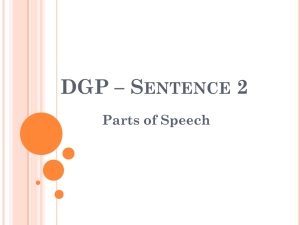The Subject and Verb in the Simple Sentence
advertisement
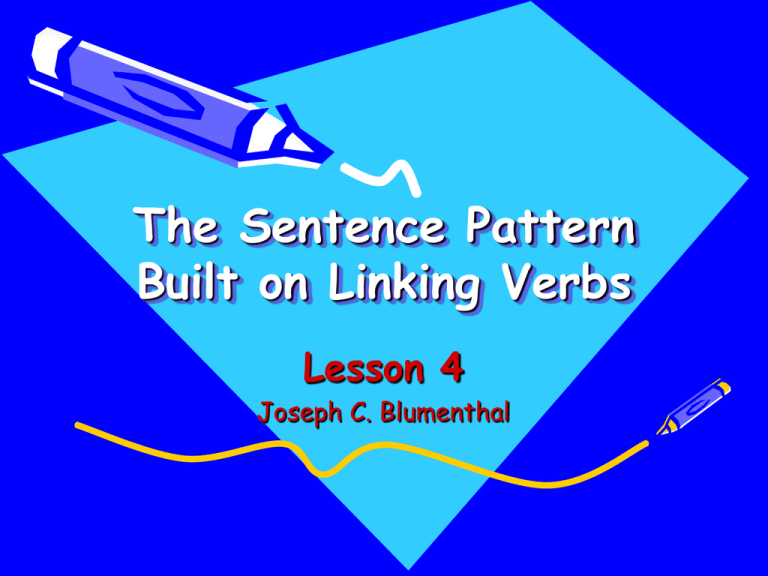
The Sentence Pattern Built on Linking Verbs Lesson 4 Joseph C. Blumenthal The Sentence Pattern Built on Linking Verbs • Suppose that you wish to point out that your friend Harry is happy. You would not be likely to say— Happy Henry Henry happy Is either of these pairs of words a sentence? (yes, No) The Sentence Pattern Built on Linking Verbs • Suppose that you wish to point out that your friend Harry is happy. You would not be likely to say— Happy Henry Henry happy Is either of these pairs of words a sentence? (yes, No) The Sentence Pattern Built on Linking Verbs a.Happy Henry b. Henry happy c.Henry is happy. Which one of these groups of words is a sentence? The Sentence Pattern Built on Linking Verbs a.Happy Henry b. Henry happy c.Henry is happy. Which one of these groups of words is a sentence? The Sentence Pattern Built on Linking Verbs a.Happy Henry b. Henry is happy The adjective happy by itself cannot make a statement about Henry. We can change a to a sentence by adding the verb ________. The Sentence Pattern Built on Linking Verbs a.Happy Henry b. Henry is happy The adjective happy by itself cannot make a statement about Henry. We can change a to a sentence by adding the verb ___ is ___. The Sentence Pattern Built on Linking Verbs a.Happy Henry b. Henry is happy The verb is helps to turn the adjective happy into a statement about the subject ________. The Sentence Pattern Built on Linking Verbs a.Happy Henry b. Henry is happy The verb is helps to turn the adjective happy into a statement about the subject __ Henry _. The Sentence Pattern Built on Linking Verbs a.Henry washed the car. b. Henry is happy Which sentence does not contain an action verb? The Sentence Pattern Built on Linking Verbs a. Henry washed the car. b. Henry is happy Which sentence does not contain an action verb? b The Sentence Pattern Built on Linking Verbs Henry is happy The verb is does not show action like washed or fixed. What does it do? The verb is ties up or links the adjective happy with the subject ________, which it describes. The Sentence Pattern Built on Linking Verbs Henry is happy The verb is does not show action like washed or fixed. What does it do? The verb is ties up or links the adjective happy with the subject _ __Henry __, which it describes. The Sentence Pattern Built on Linking Verbs Henry is happy The verb is does not show action like washed or fixed. What does it do? The verb is ties up or links the adjective happy with the subject Henry, which it describes. The Sentence Pattern Built on Linking Verbs Henry was the chairman. In this sentence, the verb was ties up or links the noun ________ with the subject Henry, which it identifies. The Sentence Pattern Built on Linking Verbs Henry was the chairman. In this sentence, the verb was ties up or links the noun chairman with the subject Henry, which it identifies. The Sentence Pattern Built on Linking Verbs Henry is happy. Henry was the chairman. A verb like is or was is called a linking verb because it links a noun, pronoun, or adjective that follows it with the _________ of the sentence. The Sentence Pattern Built on Linking Verbs Henry is happy. Henry was the chairman. A verb like is or was is called a linking verb because it links a noun, pronoun, or adjective that follows it with the __subject__ of the sentence. The Sentence Pattern Built on Linking Verbs Be is by far the most common linking verb. Be sure that you can recognize its various forms. FORMS OF BE: is, am , are-was, were, being, been The crops . . . good. Which forms of be could be used to link good with crops in the above sentence? The Sentence Pattern Built on Linking Verbs Be is by far the most common linking verb. Be sure that you can recognize its various forms. FORMS OF BE: is, am , are-was, were, being, been The crops . . . good. Which forms of be could be used to link good with crops in the above sentence? are, were, have been, or had been The Sentence Pattern Built on Linking Verbs I . . . the first speaker. FORMS OF BE: is, am , are-was, were, being, been Which forms of be could be used to link speaker with I in the above sentence? The Sentence Pattern Built on Linking Verbs I . . . the first speaker. FORMS OF BE: is, am , are-was, were, being, been Which forms of be could be used to link speaker with I in the above sentence? am, was, or had been The Sentence Pattern Built on Linking Verbs We have seen that some action verbs make complete statements about their subjects and that others do not. a.The engine started. b.The engine uses . . . In which sentence does the action verb make a complete statement? The Sentence Pattern Built on Linking Verbs We have seen that some action verbs make complete statements about their subjects and that others do not. a.The engine started. b. The engine uses . . . In which sentence does the action verb make a complete statement? a The Sentence Pattern Built on Linking Verbs However, a linking verb cannot by itself make a complete statement about its subject. Since the purpose of a link is to connect two things, a linking verb must be followed by a complement that it can link with the ______ of the sentence. The Sentence Pattern Built on Linking Verbs However, a linking verb cannot by itself make a complete statement about its subject. Since the purpose of a link is to connect two things, a linking verb must be followed by a complement that it can link with the subject of the sentence. The Sentence Pattern Built on Linking Verbs The paint was . . . (What?) Was the paint wet, dry, or sticky? Until we add a word that the linking verb was can connect with the subject, the meaning of the sentence is (complete, incomplete). The Sentence Pattern Built on Linking Verbs The paint was . . . (What?) Was the paint wet, dry, or sticky? Until we add a word that the linking verb was can connect with the subject, the meaning of the sentence is (complete, incomplete). The Sentence Pattern Built on Linking Verbs The paint was sticky. The complement sticky describes the subject _________. The Sentence Pattern Built on Linking Verbs The paint was sticky. The complement sticky describes the subject __ paint ___. The Sentence Pattern Built on Linking Verbs Now instead of using an adjective to complete our sentence, we shall use a noun as our complement. Angela was…(What?) Angela was the driver. The complement driver completes the meaning of the sentence and identifies the subject _________. The Sentence Pattern Built on Linking Verbs Now instead of using an adjective to complete our sentence, we shall use a noun as our complement. Angela was…(What?) Angela was the driver. The complement driver completes the meaning of the sentence and identifies the subject __ Angela __. The Sentence Pattern Built on Linking Verbs A complement that follows a linking verb and describes or identifies the subject is sometimes call a predicate nominative, predicate adjective, or subject complement. In this text, we shall use the term subject complement. It is called a subject complement because it describes or identifies the __________. The Sentence Pattern Built on Linking Verbs A complement that follows a linking verb and describe or identifies the subject is sometimes call a predicate nominative, predicate adjective, or subject complement. In this text, we shall use the term subject complement. It is called a subject complement because it describes or identifies the _subject__. The Sentence Pattern Built on Linking Verbs The subject complement brings us to our third sentence pattern: PATTERN III: Subject—Linking Verb ← Subject complement a.A forest ranger guards our forests. b.A forest ranger’s life is rather lonely. Which sentence is an example of Pattern III? The Sentence Pattern Built on Linking Verbs The subject complement brings us to our third sentence pattern: PATTERN III: Subject—Linking Verb ← Subject complement a. A forest ranger guards our forests. b.A forest ranger’s life is rather lonely. Which sentence is an example of Pattern III? b The Sentence Pattern Built on Linking Verbs Some cameras are very expensive. The subject complement that follows the linking verb in this sentence is ________. The Sentence Pattern Built on Linking Verbs Some cameras are very expensive. The subject complement that follows the linking verb in this sentence is expensive. The Sentence Pattern Built on Linking Verbs FORMS OF BE: am, is, are—was, were, been Although a form of be can be used by itself as a linking verb, it is often used as a helper with the main verb. a.The leaves are green. b.The leaves are falling. In which sentence is are used as a helper? The Sentence Pattern Built on Linking Verbs FORMS OF BE: am, is, are—was, were, been Although a form of be can be used by itself as a linking verb, it is often used as a helper with the main verb. a. The leaves are green. b.The leaves are falling. In which sentence is are used as a helper? b The Sentence Pattern Built on Linking Verbs a.The leaves are green. b.The leaves are falling. Which sentence contains a subject complement? The Sentence Pattern Built on Linking Verbs a.The leaves are green. b. The leaves are falling. Which sentence contains a subject complement? The Sentence Pattern Built on Linking Verbs a.The fans were cheering. b.The fans were enthusiastic. One of the italicized words is part of an action verb; the other is a subject complement. The subject complement is the word ________. The Sentence Pattern Built on Linking Verbs a.The fans were cheering. b.The fans were enthusiastic. One of the italicized words is part of an action verb; the other is a subject complement. The subject complement is the word enthusiastic. The Sentence Pattern Built on Linking Verbs Be is not the only linking verb. Among other verbs that can serve as linking verbs are seem, become, appear, look, feel, and get (when it means become). The candidate appeared cheerful. The linking verb in this sentence is ________. The Sentence Pattern Built on Linking Verbs Be is not the only linking verb. Among other verbs that can serve as linking verbs are seem, become, appear, look, feel, and get (when it means become). The candidate appeared cheerful. The linking verb in this sentence is appeared. The Sentence Pattern Built on Linking Verbs The animals . . . cold. Underline the two words that can be used as linking verbs in the above sentence. feel like look avoid The Sentence Pattern Built on Linking Verbs The animals . . . cold. Underline the two words that can be used as linking verbs in the above sentence. feel like look avoid The Sentence Pattern Built on Linking Verbs a. The customer feels the material. b. The weather feels muggy. You can be sure that a verb is a linking verb if you can put some form of be (is, am, are-was, were, been) in its place. In which sentence can you substitute is for feels? The Sentence Pattern Built on Linking Verbs a. The customer feels the material. b. The weather feels muggy. You can be sure that a verb is a linking verb if you can put some form of be (is, am, are-was, were, been) in its place. In which sentence can you substitute is for feels? The Sentence Pattern Built on Linking Verbs a. The customer feels the material. b. The weather feels muggy. In one sentence feels is used as an action verb; in the other it is used as a linking verb. In which sentence is it used as a linking verb? The Sentence Pattern Built on Linking Verbs a. The customer feels the material. b. The weather feels muggy. In one sentence feels is used as an action verb; in the other it is used as a linking verb. In which sentence is it used as a linking verb? The Sentence Pattern Built on Linking Verbs a.The restaurant looked crowded. b.The speaker looked at his watch. In which sentence can you substitute was for looked? The Sentence Pattern Built on Linking Verbs a.The restaurant looked crowded. b.The speaker looked at his watch. In which sentence can you substitute was for looked? The Sentence Pattern Built on Linking Verbs a.The restaurant looked crowded. b.The speaker looked at his watch. In one sentence, looked is used as an action verb; in the other, as a linking verb for which we could substitute was. In which sentence is looked used as a linking verb and followed by a subject complement? The Sentence Pattern Built on Linking Verbs a.The restaurant looked crowded. b.The speaker looked at his watch. In one sentence, looked is used as an action verb; in the other, as a linking verb for which we could substitute was. In which sentence is looked used as a linking verb and followed by a subject complement? a The Sentence Pattern Built on Linking Verbs We have now studied two kinds of complements: direct objects and subject complements. With a little reasoning, we can avoid confusing the two. A direct object can follow only an action verb. A subject complement always follows a _________ verb. The Sentence Pattern Built on Linking Verbs We have now studied two kinds of complements: direct objects and subject complements. With a little reasoning, we can avoid confusing the two. A direct object can follow only an action verb. A subject complement always follows a linking verb. The Sentence Pattern Built on Linking Verbs Usually, the subject and direct object are two different things, and the action passes from one to the other. 1--------------------------> 2 The heavy downpour flooded many basements. The action passes from downpour to __________. The Sentence Pattern Built on Linking Verbs Usually the subject and direct object are two different things, and the action passes from one to the other. 1--------------------------> 2 The heavy downpour flooded many basements. The action passes from downpour to basements. The Sentence Pattern Built on Linking Verbs A subject complement, however, always means the same thing as the subject or describes the subject. We are dealing with one thing— not two. 1--------------> 2 a. Mrs. Ford hired a lawyer 1<------------1 b. Mrs. Ford is a lawyer. The noun lawyer is a subject complement in sentence (a, b). The Sentence Pattern Built on Linking Verbs A subject complement, however, always means the same thing as the subject or describes the subject. We are dealing with one thing— not two. 1--------------> 2 a. Mrs. Ford hired a lawyer 1<------------1 b. Mrs. Ford is a lawyer. The noun lawyer is a subject complement in sentence (a, b). The Sentence Pattern Built on Linking Verbs a.The owner of the restaurant hired a new cook. b.The owner of the restaurant is the cook. In which sentence is the noun cook a subject complement because it means the same person as the subject? _________ The Sentence Pattern Built on Linking Verbs a.The owner of the restaurant hired a new cook. b.The owner of the restaurant is the cook. In which sentence is the noun cook a subject complement because it means the same person as the subject? _________ The Sentence Pattern Built on Linking Verbs The owner of the restaurant is energetic. Because the adjective energetic describes the subject owner and is not something apart from it, energetic is a (subject complement, direct object) The Sentence Pattern Built on Linking Verbs The owner of the restaurant is energetic. Because the adjective energetic describes the subject owner and is not something apart from it, energetic is a (subject complement, direct object) The Sentence Pattern Built on Linking Verbs a.Otters are animals. b.Otters are playful animals. In both sentences, the noun animals is a subject complement that identifies the subject Otters. In sentence b, we added the adjective playful to describe the noun animals. In sentence b, the subject complement is (playful, animals) The Sentence Pattern Built on Linking Verbs a.Otters are animals. b.Otters are playful animals. In both sentences, the noun animals is a subject complement that identifies the subject Otters. In sentence b, we added the adjective playful to describe the noun animals. In sentence b, the subject complement is (playful, animals) The Sentence Pattern Built on Linking Verbs Do not mistake an adjective that describes the subject complement for the subject complement of the sentence. Otters are playful animals. The subject complement in this sentence is (the noun animals, the adjective playful) The Sentence Pattern Built on Linking Verbs Do not mistake an adjective that describes the subject complement for the subject complement of the sentence. Otters are playful animals. The subject complement in this sentence is (the noun animals, the adjective playful) The Sentence Pattern Built on Linking Verbs In the following frames write the answers on your own sheet of paper S = Subject LV = Linking Verb SC = Subject complement The Sentence Pattern Built on Linking Verbs 1. This shallow lake often gets extremely rough. Fill in the missing words: S = lake LV = _______ SC = _______ The Sentence Pattern Built on Linking Verbs 2. Hera was the powerful queen of the old Greek gods. Fill in the missing words: S = Hera LV = _______ SC = _______ The Sentence Pattern Built on Linking Verbs 3. An officer should feel responsible for those in his unit. Fill in the missing words: S = _______ LV = should feel SC = _______ The Sentence Pattern Built on Linking Verbs 4. The drunken driver is the greatest danger on our highways today. Fill in the missing words: S = driver LV = _______ SC = _______ The Sentence Pattern Built on Linking Verbs 5. The young children in the back seat were becoming very restless. Fill in the missing words: S = _______ LV = _______ SC = _______ The Sentence Pattern Built on Linking Verbs 6. The coach of the other team was looking worried. Fill in the missing words: S = _______ LV = _______ SC = _______ You are done!!! Please turn in your answers for points.
